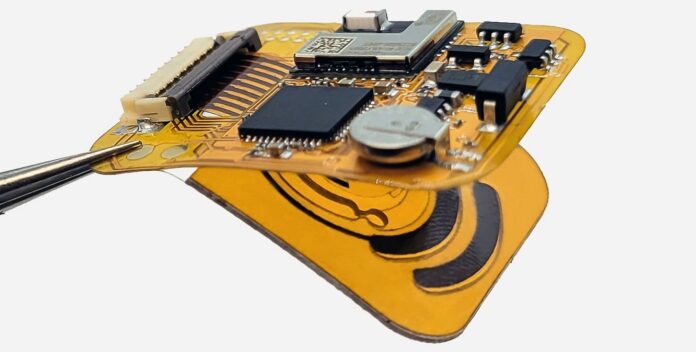Wearable sensors hold great potential in empowering personalized health monitoring, predictive analytics, and timely intervention toward personalized healthcare. Advances in flexible electronics, materials science, and electrochemistry have spurred the development of wearable sweat sensors that enable the continuous and noninvasive screening of analytes indicative of health status.
Now, researchers from the California Institute of Technology, Caltech, have developed a first-of-its-kind wearable skin sensor that can wirelessly and noninvasively detect the presence of C-reactive protein (CRP) in human sweat. This sensor will make it easier for patients and medical professionals to monitor their health without the need for more invasive blood tests.
CRP in the blood is commonly used as a biomarker of inflammation that can be caused by infection, injury, or chronic disease. But it requires complex lab equipment and personnel to analyze the blood sample.
CRP is much more difficult to detect than the molecules. One reason is that CRP is present in the blood at a much lower concentration than other biomarkers. This is largely because CRP molecules are much larger than other biomarker molecules, which means it is a lot more difficult for them to be secreted from the bloodstream into sweat. Another reason is that sensitive CRP detection usually requires special laboratory steps that wash samples to ensure consistent sensing.
“Those were the main issues that prevented people from doing wearable CRP sensing before,” said Wei Gao, corresponding author of the study. “We need high sensitivity to monitor very low-concentration CRP automatically on the skin.”
The new CRP sensor is built upon laser-engraved graphene that contains many tiny pores that create a large amount of surface area. These pores are embedded with antibodies that bind to CRP and special molecules (redox molecules) capable of generating a small electric current under certain conditions. Incorporated into the sensor’s structure are gold nanoparticles, each carrying a separate set of CRP antibodies (detector antibodies) with them.
When CRP molecules enter the sensor via sweat, they attach to both the detector antibodies on the gold nanoparticles and the antibodies on the graphene. The nanoparticles then attach to the graphene and trigger the redox molecule to generate an electrical current that can be measured by electronic components attached to the sensor. Because each gold nanoparticle contains multiple detector antibodies, they amplify the minuscule signal that a single CRP molecule would otherwise provide.
The sensor was also designed to measure the concentration of ions in the sweat, the sweat’s pH, and skin temperature to account for the influence of variations in sweat compositions from person to person on the electrochemical signal of the biosensor.
According to researchers, the work demonstrates for the first time that sweat CRP can be detected accurately and has a good correlation with its counterpart in blood, which has implications for his work in the lab and for practical medical applications.
“This is a general platform that lets us monitor extremely low-level molecules in our body fluids. We hope to expand this platform to monitor other clinically relevant protein and hormone molecules,” he says. “We also want to see if this can be used for chronic disease management. Inflammation is a risk for many patients. If they could be monitored at home, their risk can be identified, and they can be given timely treatment.”
Journal reference:
- Jiaobing Tu, Jihong Min, Yu Song, Changhao Xu, Jiahong Li, Jeff Moore, Justin Hanson, Erin Hu, Tanyalak Parimon, Ting-Yu Wang, Elham Davoodi, Tsui-Fen Chou, Peter Chen, Jeffrey J. Hsu, Harry B. Rossiter, and Wei Gao. A wireless patch for the monitoring of C-reactive protein in sweat. Nature Biomedical Engineering, 2023; DOI: 10.1038/s41551-023-01059-5
